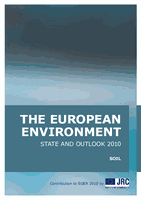
Nearly all of the food and fibres used by humans are produced on soil. Soil is also essential for
water and ecosystem health. It is second only to the oceans as a global carbon sink, with an
important role in the potential slowing of climate change. Soil functions depend on a multitude
of soil organisms which makes it an important part of our biodiversity. Nevertheless, soil in
many parts of Europe is being over-exploited, degraded and irreversibly lost due to impacts from
industrial activities and land use change, leading to soil sealing, contamination, erosion and loss of
organic carbon. Due to these problems, legislation for the protection of soils has been proposed at
EU level.

Land use shapes our environment in positive and negative ways. Productive land is a critical
resource for food and biomass production and land use strongly influences soil erosion and soil
functions such as carbon storage. Land management largely determines the beauty of Europe's
landscapes. It is important therefore to monitor land cover and land-use change through tools
such as Corine land cover. Data on land-cover change in Europe from 2000–2006 show that
growth in built-up areas and forest land leads to a continued loss of agricultural land. In turn,
global economic and environmental change will increasingly influence the way Europeans use
land (e.g. as communities work to mitigate and adapt to climate change). Policy responses are
needed to help resolve conflicting land-use demands and to guide land-use intensity to support
environmental land management.

Biodiversity — the variety of ecosystems, species and genes — is essential to human wellbeing,
delivering services that sustain our economies and societies. Its huge importance makes
biodiversity loss all the more troubling. European species are threatened with extinction and
overexploitation. Natural habitats continue to be lost and fragmented, and degraded by pollution
and climate change. Despite actions taken and progress made, these threats continue to impact
biodiversity in Europe. The new global and EU targets to halt and reverse biodiversity loss by 2020
are ambitious but achieving them will require better policy implementation, coordination across
sectors, ecosystem management approaches and a wider understanding of biodiversity's value.

The EU emitted close to 5 billion tonnes (Gt) of CO2-equivalent emissions in 2008. It contributes today around 12 % of annual global anthropogenic direct greenhouse gas emissions. The EU is making good progress towards achieving its emission reduction targets. A rapid, sustained and effective transition to a low carbon economy is necessary to mitigate climate change and to meet global greenhouse gas emission targets.

The SOER 2010 Synthesis provides an overview of the European environment's state, trends and prospects, integrating the main findings of SOER 2010.

-

* including 20 EU Member States, data not available for Greece and the United Kingdom.

The European Environment Agency (EEA) released today its fourth Environment State and Outlook report — SOER 2010 — a comprehensive assessment of how and why Europe’s environment is changing, and what we are doing about it. SOER 2010 concludes that a fully integrated approach to transforming Europe to a resource-efficient green economy can not only result in a healthy environment, but also boost prosperity and social cohesion.

-

-

Comparing the degree of soil sealing and the surface temperatures in Budapest,
Hungary

Cities are core cities following the Urban Audit definition (Eurostat, 2010). In most cases the delineation of the core city matches the urban built-up area. But in some cases the delineation also includes substantial areas outside the urban built-up areas (parts of the urban fringe and hinterland); in other cases, it includes only city centres

.

The map shows the difference in soil organic carbon content

The record is derived from several ice cores from the Antarctic ice sheet, some more than 3 km long

Simulations with LISFLOOD driven by HIRHAM HadAM3H/HadCM3 based on
IPCC SRES scenario A2.

This map shows the forest utilisation rate in 2005 (annual increment in growing stock as a percentage of annual felling) for countries in the MCPFE

Predicted changes in soil organic carbon for croplands 1990–2080. The image on the left shows changes due to climate change only while the map on the right shows changes as a result of variations in net primary production and the advent of new technologies related to crop management (e.g. machinery, pesticides, herbicides, agronomic knowledge of farmers) and breeding (development of higher yielding varieties through improved stress resistance and/or yield potential) that result in yield increases.

-Magistrale für Europa

SOER2010-title: Contamited sites in Europe, 2006.
The graphs shows the status of identification and clean‑up of contaminated sites in Europe as reported to the European Environment Agency through the Eionet priority data flows on contaminated sites. While trends vary across Europe, it is clear that the remediation of contaminated sites is still a significant undertaking.
